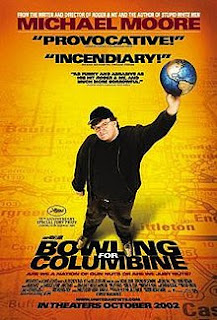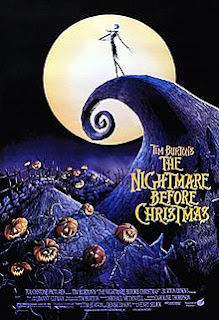Bowling for Columbine (2002)
Guns. They are both fascinating and very deadly. Over the years, people have used guns as a means for two different kinds of activities: hunting and protection. The later is being considered one of the most dangerous forms of defense in more recent times. Control with guns is still a relevant issue that plagues many people and politicians. Especially, in the United States of America. In fact, the Second Amendment to the United States Constitution has the statement proclaiming that a person can have the right to own a weapon in their household, should they so desire. But, the leitmotif has become something that can bring up controversy, especially when used in the wrong manner. And nowhere is that more explored than in the 2002 documentary feature “Bowling for Columbine” directed by Michel Moore. Moore's film chronicles the infamous high school shooting, and puts into play, the dangers of trying to be safe in the United States. While there are some minor problems with the movie in general, as a whole, the film is a disturbing look at how guns, shootings, and safety is relevant from a time when fear was at an all-time high in the country; or even around the world. “Bowling for Columbine” is a deep, yet fascinating look at how fear can form from just a simple tool of destruction.
Moore's documentary explores a vast array of topics relating or revolving around the Columbine massacre of 1999.
One of these subjects, of course, is gun control. Many interviews in the film claim that the right to own a gun is because of natural instinct. Being a citizen of the United States of America, and determined by the Second Amendment of the Constitution, indicates that one should own a firearm of some kind. Moore uses this to shock audiences on the fact that anyone could own a gun, not think of the consequences being involved. Obviously, there has to be some sort of protection and some sort of conscience involved, but at the time of Moore's film being shown to the general public, it seemed like every American didn't seem to care in the slightest. This goes especially true for local family stores like K-Mart or Wal-Mart which sell firearms to the general public, and are a prime example in the movie.
Another topic of interest showcased in the movie, and a personal pet peeve of mine, is the use of media to display how violence can be portrayed. Violence in media is nothing more than art, like all entertainment, is done as a performance. So, by providing examples like certain movies at the time like “The Matrix”, and TV shows like 'Cops', and celebrities like Chris Rock and especially Marilyn Manson, just fuel the debate on why gun violence occurs even further. Plus, this leads to one of my complaints on “Bowling for Columbine” in general: the final interview with Charlton Heston. Heston, was a major movie star, and, at the time, president of the National Rifle Association (NRA). Moore interviews Heston at the climax of the movie, and it looks like Heston doesn't seem to care about the subject material being asked.. If the interview had been more engaging enough, and didn't seem to end quite abruptly, then it would have made the whole conversation all the more interesting. But as it is, the interview was merely a big disappointment.
Another topic of discussion that Moore explores, is the safety of the American citizen. As well as making the distinct fact that the United States is the safest place on planet Earth. When the reality is, there are other countries out there that have done more heinous acts of violence and destruction; even with with support from the United States, as with the case of several countries in the Middle East like Iraq and Afghanistan. But the big example that Moore uses in the movie is with our neighbors to the north: Canada. The shocking facts that Canadians have low crime rates and worry less about security issues (keep in mind, the film was released right after 9/11), will definitely raise some eyebrows from several viewers. By using different countries, including Canada, Moore puts the United States of America on the edge in terms of security.
One final topic of discussion in “Bowling for Columbine”, is the subject of race. Moore points out, that a large portion of African Americans are the main cause/blame for murders, or acts of violence. Moore also points out that through interviews with media executives, it is more interesting and more engaging to follow African Americans for crimes that they have committed. As well as the fact that African Americans seem to be the case of many crimes which they did not commit. By using race, Moore also uses the subject as an example of a school shooting that took a young girls' life. The evidence behind the shooting involved, includes some shocking background material on the parents, and how gun control needs to be enforced. However, this particular moment goes on way too long, and could have been edited down by a bit.
As for the rest of the film, “Bowling for Columbine” is quite good. The footage and interviews that Moore collaborates with, is insightful, thoughtful, shocking, and overall, extraordinary in every detail, and provides more insight into the subject at hand. There is particularly a rather funny moment which occurs in the middle of the movie, where there is an animated segment detailing a brief history of the United States, and it is done in a very comic way. The movie is shocking, informative, and makes the viewer think about the quality of gun control here in the United States. Especially, at the time of this writing, in today's strong and controversial political climate.
In conclusion, “Bowling for Columbine” will more than definitely make viewers both raise their eyebrows, and educate their brains on how they use a very dangerous weapon.




Comments
Post a Comment